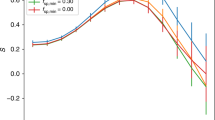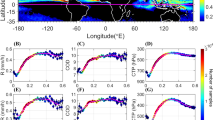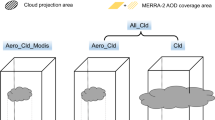Abstract
Atmospheric aerosols affect cloud properties, and thereby the radiation balance of the planet and the water cycle. However, the influence of aerosols on clouds, and in particular on precipitation, is far from understood1, and seems to depend on factors such as location, season2 and the spatiotemporal scale of the analysis. Here, we examine the relationship between aerosol abundance and rain rate—a key factor in climate and hydrological processes—using rain data from a satellite-based instrument sensitive to stronger rain rates (Tropical Rainfall Measuring Mission3, TRMM), aerosol and cloud property data from the Moderate Resolution Imaging Spectroradiometer onboard the Aqua satellite4,5 and meteorological information from the Global Data Assimilation System6. We show that for a range of conditions, increases in aerosol abundance are associated with the local intensification of rain rates detected by the TRMM. The relationship is apparent over both the ocean and land, and in the tropics, subtropics and mid-latitudes. Further work is needed to determine how aerosols influence weaker rain rates, not picked up in the analysis. We also find that increases in aerosol levels are associated with a rise in cloud-top height. We suggest that the invigoration of clouds and the intensification of rain rates is a preferred response to an increase in aerosol concentration.
This is a preview of subscription content, access via your institution
Access options
Subscribe to this journal
Receive 12 print issues and online access
$259.00 per year
only $21.58 per issue
Buy this article
- Purchase on Springer Link
- Instant access to full article PDF
Prices may be subject to local taxes which are calculated during checkout



Similar content being viewed by others
References
IPCC Climate Change 2007: The Physical Science Basis (eds Solomon, S. et al.) (Cambridge Univ. Press, 2007).
Khain, A. P. Notes on state-of-the-art investigations of aerosol effects on precipitation: A critical review. Environ. Res. Lett. 4, 015004 (2009).
Huffman, G. J. et al. The TRMM multisatellite precipitation analysis (TMPA): Quasi-global, multiyear, combined-sensor precipitation estimates at fine scales. J. Hydrometeorol. 8, 38–55 (2007).
Platnick, S. et al. The MODIS cloud products: Algorithms and examples from Terra. IEEE Trans. Geosci. Remote Sensing 41, 459–473 (2003).
Remer, L. A. et al. Global aerosol climatology from the MODIS satellite sensors. J. Geophys. Res. 113, D14S07 (2008).
Parrish, D. F. & Derber, J. C. The National-Meteorological-Centers spectral statistical-interpolation analysis system. Mon. Weath. Rev. 120, 1747–1763 (1992).
Twomey, S. The influence of pollution on the shortwave albedo of clouds. J. Atmos. Sci. 34, 1149–1152 (1977).
Koren, I., Martins, J. V., Remer, L. A. & Afargan, H. Smoke invigoration versus inhibition of clouds over the Amazon. Science 321, 946–949 (2008).
Albrecht, B. A. Aerosols, cloud microphysics and fractional cloudiness. Science 245, 1227–1230 (1989).
Rosenfeld, D. Flood or drought: How do aerosols affect precipitation? Science 321, 1309–1313 (2008).
Stevens, B. & Feingold, G. Untangling aerosol effects on clouds and precipitation in a buffered system. Nature 46, 607–613 (2009).
L’Ecuyer, T. S., Berg, W., Haynes, J., Lebsock, M. & Takemura, T. Global observations of aerosol impacts on precipitation occurrence in warm maritime clouds. J. Geophys. Res. 114, D09211 (2009).
Levin, Z. & Cotton, W. R. Aerosol Pollution Impact on Precipitation: A Scientific Review (Springer, 2009).
Teller, A. & Levin, Z. The effects of aerosols on precipitation and dimensions of subtropical clouds: A sensitivity study using a numerical cloud model. Atmos. Chem. Phys. 6, 67–80 (2006).
Rosenfeld, D. Suppression of rain and snow by urban and industrial air pollution. Science 287, 1793–1796 (2000).
Huang, J., Zhang, C. & Prospero, J. M. Large-scale effect of aerosols on precipitation in the West African Monsoon region. Q. J. R. Meteorol. Soc. 135, 581–594 (2009).
Jiang, J. H. et al. Clean and polluted clouds: Relationships among pollution, ice clouds, and precipitation in South America. Geophys. Res. Lett. 35, L14804 (2008).
Jones, T. A. & Christopher, S. A. Statistical properties of aerosol-cloud-precipitation interactions in South America. Atmos. Chem. Phys. 10, 2287–2305 (2010).
Lin, J. C., Matsui, T., Pielke, R. A. Sr & Kummerow, C. Effects of biomass-burning-derived aerosols on precipitation and clouds in the Amazon Basin: A satellite-based empirical study. J. Geophys. Res. 111, D19204 (2006).
Martins, J. A., Silva Dias, M. A. F. & Gonçalves, F. L. T. Impact of biomass burning aerosols on precipitation in the Amazon: A modelling case study. J. Geophys. Res. 114, D02207 (2009).
Tao, W-K. et al. Role of atmospheric aerosol concentration on deep convective precipitation: Cloud-resolving model simulations. J. Geophys. Res. 112, D24S18 (2007).
Andreae, M. O. Correlation between cloud condensation nuclei concentration and aerosol optical thickness in remote and polluted regions. Atmos. Chem. Phys. 9, 543–556 (2009).
Koren, I., Feingold, G. & Remer, L. A. The invigoration of deep convective clouds over the Atlantic: Aerosol effect, meteorology or retrieval artifact? Atmos. Chem. Phys. 10, 8855–8872 (2010).
Andreae, M. O. Smoking rain clouds over the Amazon. Science 303, 1337–1342 (2004).
Khain, A. P., BenMoshe, N. & Pokrovsky, A. Factors determining the impact of aerosols on surface precipitation from clouds: An attempt at classification. J. Atmos. Sci. 65, 1721–1748 (2008).
Lindsey, D. T. & Fromm, M. Evidence of the cloud lifetime effect from wildfire-induced thunderstorms. Geophys. Res. Lett. 35, L22809 (2008).
Lee, S. S., Donner, L. J. & Penner, J. E. Thunderstorm and stratocumulus: How does their contrasting morphology affect their interactions with aerosols? Atmos. Chem. Phys. 10, 6819–6837 (2010).
van den Heever, S. C. & Cotton, W. R. Urban aerosol impacts on downwind convective storms. J. Appl. Meteorol. Clim. 46, 828–850 (2007).
Gagin, A., Rosenfeld, D. & López, R. E. The relationship between height and precipitation characteristics of summertime convective cells in south Florida. J. Atmos. Sci. 42, 84–94 (1985).
Rosenfeld, D. & Ulbrich, C. W. Cloud microphysical properties, processes, and rainfall estimation opportunities. Meteorol. Monogr. 30, 237–237 (2003).
Acknowledgements
This work was supported in part by the Israel Science Foundation (grant # 1172/10) and the Minerva Foundation (780048). G.F. acknowledges support from NOAA’s Climate Goal Program.
Author information
Authors and Affiliations
Contributions
I.K. carried out the analysis and wrote the paper. All authors discussed the results and implications and commented on the manuscript at all stages.
Corresponding author
Ethics declarations
Competing interests
The authors declare no competing financial interests.
Supplementary information
Supplementary Information
Supplementary Information (PDF 1142 kb)
Rights and permissions
About this article
Cite this article
Koren, I., Altaratz, O., Remer, L. et al. Aerosol-induced intensification of rain from the tropics to the mid-latitudes. Nature Geosci 5, 118–122 (2012). https://doi.org/10.1038/ngeo1364
Received:
Accepted:
Published:
Issue Date:
DOI: https://doi.org/10.1038/ngeo1364
This article is cited by
-
Identification of sources and sinks of atmospheric aerosols and their impact on east African rainfall
Acta Geophysica (2023)
-
Evaluation of the influence of El Niño-Southern Oscillation on air quality in southern China from long-term historical observations
Frontiers of Environmental Science & Engineering (2022)
-
Influence of aerosols on clouds, precipitation and freezing level height over the foothills of the Himalayas during the Indian summer monsoon
Climate Dynamics (2021)
-
PM2.5 over North China based on MODIS AOD and effect of meteorological elements during 2003–2015
Frontiers of Environmental Science & Engineering (2020)
-
Aerosol size distribution using Thailand ground-based instruments and climate variables
Theoretical and Applied Climatology (2020)



